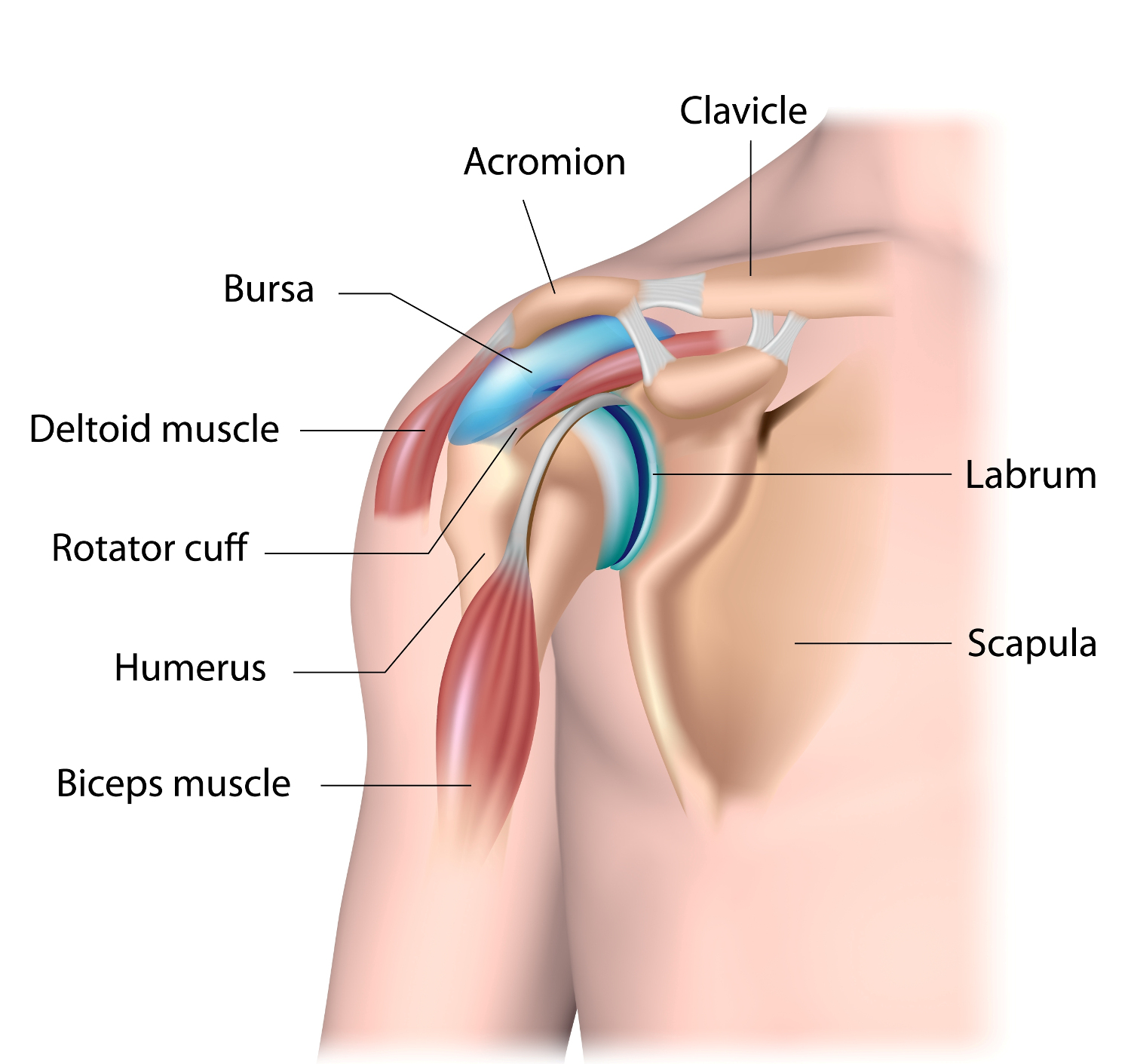
Shoulder Bursitis
What is Shoulder Bursitis?
Shoulder bursitis happens when the bursa in the shoulder becomes inflamed. The bursa is a fluid-filled sac inside the shoulder joint. Usually, it prevents friction that occurs between the bones of a joint. However, overuse, injury, or certain medical conditions, such as rheumatoid arthritis, may lead to the painful inflammation of the bursa. This is what is known as shoulder bursitis, or subacromial bursitis.
Interestingly, shoulder pain impacts about 4-26% of the general population 1. Working-aged individuals and those involved in competitive or recreational sports are more likely to experience shoulder pain, including shoulder bursitis. In fact, the shoulder is one of the most vulnerable joints in the human body. A healthy shoulder joint has a wide range of motion. You can move your shoulder in full circles. You can lift it up, down, back, forward, and out to the side. It’s the most mobile joint in the body. Unfortunately, this makes it highly susceptible to injury, including bursitis. Luckily, shoulder bursitis is very treatable through medical help, as well as via at-home treatments.
What are the Symptoms of Shoulder Bursitis?
Shoulder bursitis symptoms may include:
- Pain on the outside or top of the shoulder.
- Pain or tenderness when touching the shoulder joint.
- Pain that feels worse when you try to lift your arm.
- Pain when pushing to open a door.
- Pain when lying on your shoulder.
- Pressure on the top of the shoulder.
- Decreased shoulder range of motion.
- Redness and warmth around the shoulder area.
- Swelling around the shoulder joint.
In rare and severe cases, shoulder bursitis may further be accompanied by a fever. If this is the case, the bursa may be infected and you should seek out medical care.
Can Shoulder Bursitis Cause Neck Pain?
Shoulder and neck pain are frequently hard to differentiate between. Further, these two structures are very close to each other, meaning if one area is impacted or in pain, it may affect the other area. Thus, shoulder bursitis may result in increased neck pain.
Why does this happen? Shoulder bursitis causes less space availability in the shoulder due to inflammation. This leads to reduced range of motion, since tendons and muscles require enough space to glide over other structures and move. With time, this may leave weakened muscles in the shoulder and the neck muscle may work to compensate. Since these muscles in the neck are not made to perform or help in certain movements, it may result in muscle strain and pain. However, this is more likely to occur in chronic shoulder bursitis cases and less likely to happen in more acute cases.
Further, shoulder bursitis may result from injuries, such as a shoulder impingement 2. In fact, shoulder impingement may lead to chronic neck pain issues, and those experiencing neck pain may benefit from shoulder impingement treatment methods 3.
Can Shoulder Bursitis Cause Pins and Needles?
In some cases, shoulder bursitis may result in pins and needles. This is known as a ‘pinched nerve.’ The inflamed bursa may press on a nerve, causing tingling sensations down the arm or through the neck. This type of symptom in relation to shoulder bursitis is usually associated with overuse or a recurring injury. Usually, shoulder bursitis treatment alleviates the problem, assuming it is, in fact, the root cause of it.
What Causes Shoulder Bursitis?
Shoulder bursitis is frequently due to overuse, injury, or a medical condition. Overuse often occurs through daily activities, such as those required in one’s job, recreational activities, or daily life. For example, carpenters, gardeners, and other labor-intensive occupations are more likely to experience shoulder bursitis. Using a hammer frequently throughout the day or performing numerous reaching movements may irritate the bursa. Athletes are also more susceptible, particularly those who use frequent shoulder movements to perform their sport of choice. For instance, a baseball pitcher or tennis player may be more likely to experience shoulder bursitis than a soccer player.
Other injuries may also lead to shoulder bursitis. A direct impact to the shoulder may result in an irritated bursa. Further, shoulder impingement syndrome is a very common injury causing shoulder bursitis 4. A shoulder impingement occurs when the subacromial space becomes reduced. With an impingement injury, tendonitis, inflammation of the tendon, may also occur, along with inflammation of the bursa. This is due to a reduced amount of space at the joint, which creates increased friction between structures.
Common medical conditions that contribute to bursitis of the shoulder include rheumatoid arthritis 5. Rheumatoid arthritis is a chronic autoimmune condition where the body’s own immune system attacks the joints. Swelling and pain in the wrist are common symptoms of this type of arthritis. As such, individuals with rheumatoid arthritis are more likely to experience irritated and inflamed bursa sacs at their joints, such as bursitis at the shoulder.

How is Bursitis of the Shoulder Diagnosed?
A sports medicine doctor or physiotherapist diagnoses shoulder bursitis through a variety of tests. These tests may involve movements of the shoulder, as well as pinpointing the location of your pain. For mild forms of bursitis, you may not even require medical treatment or diagnosis. However, in more severe cases, your medical practitioner may aspirate the bursa at the shoulder to extract the fluid build-up for further testing. This is commonly done in cases where septic bursitis, meaning an infection is present, is suspected. If the bursa is infected, surgery may be required.
In addition, imaging diagnostic tests may be performed to rule out other causes of your shoulder pain and inflammation. For example, a doctor or physical therapist may require an MRI or ultrasound to ensure bursitis is actually causing your symptoms.
How to Prevent Shoulder Bursitis?
When it comes to preventing shoulder bursitis, you’ll want to steer clear of repetitive or ongoing strain on the shoulder joint. These means ensuring you properly warm-up the joint before use. Dynamic stretches, such as arm swings, are particularly good for warming up this area of the body. Gentle exercises may also help strengthen the shoulder joint, decreasing your risk of injury. You should also take many breaks when using the shoulder. If it starts to ache (or even before this point), switch activities.
Posture also plays a major role when it comes to shoulder injuries. Research indicates that improper or ‘bad’ posture, such as thoracic extension, may contribute to increased shoulder pain due to increased demand on the shoulder joint and surrounding tissues 6. By correcting your posture or performing posture-supporting exercises, such as the seated row, you may significantly reduce your chances of experiencing shoulder bursitis.
How is Shoulder Bursitis is Treated?
Frequently, adequate rest is sufficient enough to reduce the symptoms and heal shoulder bursitis. However, the use of multiple therapies and treatment methods prove to be best in combating shoulder bursitis, as well as ensuring it doesn’t become a chronic or recurring condition. Most cases of shoulder bursitis resolve within a few weeks. The following outlines various common treatment methods used for shoulder bursitis.
1. Rest
As aforementioned, rest is critical to reduce and eliminate symptoms. By performing the activities that caused your shoulder pain in the first place, you may experience greater pain and discomfort. It’s best to rest your shoulder until the pain has subsided. Once the pain has disappeared, gradually ease back into using it with simple movements or exercises.
2. Medications
Some individuals may turn to over-the-counter medications to help cope with their pain and inflammation. Non-steroidal anti-inflammatory drugs, NSAIDs, may help decrease your shoulder inflammation and thus, reduce your pain. NSAIDs that may be recommended include Ibuprofen or Naproxen. Acetaminophen may also decrease your pain. Yet, NSAIDs are not a permanent solution, and you should avoid taking these medications for longer than 10 days 7.
Steroid injections are another form of medication that can help lessen your pain. A doctor injects corticosteroids in or near the bursa. This temporarily decreases pain and inflammation. Yet, it isn’t a permanent fix. Most medication should be combined with other treatment methods.
3. Ice
Icing the area may help reduce pain by numbing the area. Apply the ice pack for 10-15 minutes at a time. Ensure you place a cloth or towel in between the ice pack and your skin, and make sure to leave at least 45 minutes in between applications.
4. Shoulder Bracing
Shoulder bracing or taping can help remind you to rest your shoulder. It provides feedback to let you know that your joint needs time to heal.
5. Exercises and Physiotherapy
Physiotherapy can help you bounce back, especially when shoulder bursitis won’t go away. Your physiotherapist can provide manual techniques and prescribe exercises to ease you back into your daily activities. Exercises often involve gentle stretching and strengthening movements. It may also involve postural and upper back strengthening to prevent strain on the shoulder.
6. Lifestyle Approaches
Many self-care strategies can also help you recover, as well as prevent recurrence. These include:
- Sleep Strategies: Ensure you get 7-9 hours of quality sleep per night. Sleep hygiene, including your bedtime routine, is also important. By getting a good night’s rest, you give your body the time it needs to heal and recover.
- Daily Movement: The body isn’t meant to be sedentary. By getting daily movement in, you’ll optimize the function and workings of all your body’s systems.
- Social Support: Research indicates that individuals with high amounts of social support are more likely to experience reductions in their pain levels 8.
- Nutrition: What you put in your body may determine how fast and how well you recover. It also impacts your mood and all the processes within your body.
- Relaxing: Relaxation is another essential part to overall balance. It gives your body time to recover and rest. Try meditation, breathing techniques, or journaling.
In rare cases, you may require surgery. If your shoulder bursitis fails to respond to any non-invasive treatment methods within 6 months to a year, your doctor may recommend surgery to help repair any damage to the bursa.
Can Massage Help Shoulder Bursitis?
Research indicates massage as an effective method to treat shoulder pain 9. Massage is particularly useful when shoulder bursitis is related to other injuries. Often, massage to the bursa itself will result in increased pain and problems. Yet, massage therapy applied by a licensed and trained professional to the surrounding area can help relieve muscle tension, reduce symptoms associated with tendonitis, and help increase range of motion. For instance, friction massage can prove useful to treat tendonitis, but is not recommended to apply to an inflamed bursa.
By using massage techniques on the surrounding muscle tissue and myofascial tissue, circulation may increase, bringing more cells and oxygen to the affected area. In turn, this helps you heal faster. Further, massage can help improve your range of motion through a quicker healing process and decreased muscle tension. Deep tissue massage, in particular, to the area surrounding your shoulder joint may produce these effects.
Massage therapy, specifically a Swedish massage, further has a relaxing response. With improved relaxation and activation of your parasympathetic nervous system (your rest and digest system), you may sleep better which can, again, improve your body’s healing capabilities.
Before booking a massage appointment, ask your physician whether or not massage therapy would prove useful for your specific situation. Your doctor may then refer you to a massage therapist, as well as provide the therapist with other pertinent information regarding your condition. At each massage appointment, your therapist will ask you how you’re feeling and if there has been any changes in your pain or symptoms since your last visit. Throughout your session, make sure to communicate with your therapist. Let them know if you’re experiencing any increased pain or discomfort during your massage, and they will adjust accordingly. Feedback allows your massage therapist to do their job right and is highly encouraged. It will further help dictate your treatment, and allow your therapist to know what’s working and what’s not.
Use massage in combination with other treatment methods to improve your shoulder bursitis and potentially help prevent future incidents.
References
1. Murphy RJ, Carr AJ. “Shoulder pain,” BMJ Clin Evid. 2010;2010:1107.
2. Faruqi T, Rizvi T. “Subacromial Bursitis,” StatPearls. Jan 2020.
3. Gorski, Jerrold M, Schwartz, Lawrence H. “Shoulder Impingement Presenting as Neck Pain,” The Journal of Bone & Joint Surgery. April 2003; 85(4), pp 635-638.
4. Faruqi T, Rizvi T. “Subacromial Bursitis,” StatPearls. Jan 2020.
5. Laine V, Pekanmaki K, Vainio K. “Shoulder Affections in Rheumatoid Arthritis,” Annals of the Rheumatic Diseases. 1954 Jun; 13(2): 157–160. doi: 10.1136/ard.13.2.157.
6. Honda K, Izumi S, et al. “Influence of thoracic posture on scapulothoracic and glenohumeral motions during eccentric shoulder external rotation.” Gait & Posture. January 2019; 67, pp 207-212.
7. Castellsague, J., Riera-Guardia, N., Calingaert, B. et al. “Individual NSAIDs and Upper Gastrointestinal Complications.” Drug Saf 35, 1127–1146 (2012).
8. Chiang LM, Godstein MS, Hurwitz EL, Morgenstern H. “The impact of psychosocial factors on neck pain and disability outcomes among primary care patients: results from the UCLA Neck Pain Study.” Disabil Rehabil. 2006 Nov 15;28(21):1319-29.
9. Young-Ran Y. “Effectiveness of massage therapy for shoulder pain: a systematic review and meta-analysis.” Journal of Physical Therapy Science. 2017 May; 29(5): 936–940.


